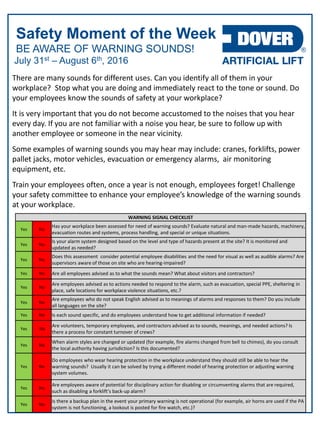
Dover ALS Safety Moment of the Week 02-Aug-2016
- 1. BE AWARE OF WARNING SOUNDS! Safety Moment of the Week July 31st – August 6th, 2016 There are many sounds for different uses. Can you identify all of them in your workplace? Stop what you are doing and immediately react to the tone or sound. Do your employees know the sounds of safety at your workplace? It is very important that you do not become accustomed to the noises that you hear every day. If you are not familiar with a noise you hear, be sure to follow up with another employee or someone in the near vicinity. Some examples of warning sounds you may hear may include: cranes, forklifts, power pallet jacks, motor vehicles, evacuation or emergency alarms, air monitoring equipment, etc. Train your employees often, once a year is not enough, employees forget! Challenge your safety committee to enhance your employee’s knowledge of the warning sounds at your workplace. WARNING SIGNAL CHECKLIST Yes No Has your workplace been assessed for need of warning sounds? Evaluate natural and man-made hazards, machinery, evacuation routes and systems, process handling, and special or unique situations. Yes No Is your alarm system designed based on the level and type of hazards present at the site? It is monitored and updated as needed? Yes No Does this assessment consider potential employee disabilities and the need for visual as well as audible alarms? Are supervisors aware of those on site who are hearing-impaired? Yes No Are all employees advised as to what the sounds mean? What about visitors and contractors? Yes No Are employees advised as to actions needed to respond to the alarm, such as evacuation, special PPE, sheltering in place, safe locations for workplace violence situations, etc.? Yes No Are employees who do not speak English advised as to meanings of alarms and responses to them? Do you include all languages on the site? Yes No Is each sound specific, and do employees understand how to get additional information if needed? Yes No Are volunteers, temporary employees, and contractors advised as to sounds, meanings, and needed actions? Is there a process for constant turnover of crews? Yes No When alarm styles are changed or updated (for example, fire alarms changed from bell to chimes), do you consult the local authority having jurisdiction? Is this documented? Yes No Do employees who wear hearing protection in the workplace understand they should still be able to hear the warning sounds? Usually it can be solved by trying a different model of hearing protection or adjusting warning system volumes. Yes No Are employees aware of potential for disciplinary action for disabling or circumventing alarms that are required, such as disabling a forklift’s back-up alarm? Yes No Is there a backup plan in the event your primary warning is not operational (for example, air horns are used if the PA system is not functioning, a lookout is posted for fire watch, etc.)?
- 2. Safety Moment of the Week July 31st – August 6th , 2016 BE AWARE OF WARNING SOUNDS! Why is Sound Important? - Whether operating a machine, driving your car or reading in the library, sound provides you with information about the world around you. Sound serves two basic functions for people around the world: signalling and communication. In the workplace we use sound to signal us that there is a hazard or emergency. Signalling - Sound provides a unique form of signalling - it is omni-directional, meaning that it can signal an object or event that is completely out of sight and beyond your tactile senses. For example, when you hear some sirens you look up but are unable to see any flashing lights, yet, you know that there is an emergency vehicle (e.g., an ambulance) several blocks away. You have a good idea about the direction from which the sound is coming and you can tell if it is moving closer or further away. Know the different types of warning sounds in your work environment and what your responsibilities are when you hear them, it could save someone’s life! Warning sounds may come in different forms such as: Bells: Vibrating bells are the most common signal device. Bells are commonly used in schools for fire alarms. Horns: They produce a very loud distinctive sound that immediately attracts attention. Horns can be useful to call attention to critical situations. Sirens: They produce a loud piercing wail that makes them ideally suitable for initiating a site-wide evacuation. Portable Radio or Workplace Announcement System: Speakers can be used to play a live or recorded voice message. They are often ideally suited for large workplaces where phased or guided evacuations are needed. Visual Alarms: These use steady, flashing, or strobe lights to alert workers to an emergency situation in areas where noise levels are high, especially where ear protection must be worn and audible signals may not be heard or may be misunderstood. Visual signals also provide an effective way to alert workers with hearing loss about an emergency.
